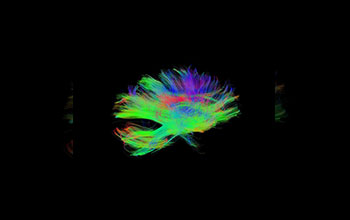Multimedia Gallery
Elegant wisps are white matter "skeletons" of a chimpanzee brain
Elegant wisps are white matter "skeletons" of a chimpanzee brain. White matter carries nerve impulses between nerve cells. The skeletons are created using diffusion tensor imaging (DTI), a technique that specifically teases out the location and orientation of white matter.
More about this image
DTI is one imaging technique researchers are using to identify regions in the brain that change when humans learn how to use technology. By looking at both human and chimpanzee brains, it may be possible to determine whether and how the human brain adapted to support technology skills that are uniquely human from stone toolmaking to computer programming.
This research was supported in part by a grant from the National Science Foundation (grant SMA 13-28567, "IBSS: The Interrelated Development of Language and Technology"). (Date image taken: human data: 2015; chimpanzee data: 2013; date originally posted to NSF Multimedia Gallery: May 3, 2017)
Credit: Erin Hecht, Center for Behavioral Neuroscience, Georgia State University; data credit: Erin Hecht, Yerkes National Primate Research Center
Images and other media in the National Science Foundation Multimedia Gallery are available for use in print and electronic material by NSF employees, members of the media, university staff, teachers and the general public. All media in the gallery are intended for personal, educational and nonprofit/non-commercial use only.
Images credited to the National Science Foundation, a federal agency, are in the public domain. The images were created by employees of the United States Government as part of their official duties or prepared by contractors as "works for hire" for NSF. You may freely use NSF-credited images and, at your discretion, credit NSF with a "Courtesy: National Science Foundation" notation.
Additional information about general usage can be found in Conditions.
Also Available:
Download the high-resolution JPG version of the image. (221.0 KB)
Use your mouse to right-click (Mac users may need to Ctrl-click) the link above and choose the option that will save the file or target to your computer.



